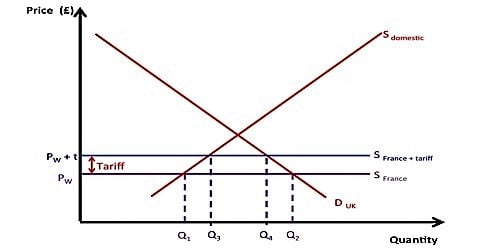Trade creation: Trade creation occurs when production shifts to more efficient producers for reasons of comparative advantages, allowing consumers access to more goods at a lower price than would have been possible without integration. It refers to the situation where higher cost products (imported or domestically produced) are replaced by lower cost imports.
Trade diversion: Trade diversion occurs when trade shifts to countries in the group at the expense of trade with countries not in the group, even though the nonmember companies might be more efficient in the absence of trade barriers. It means that higher cost suppliers replace lower cost external suppliers within the free trade area. A regional free trade agreement will benefit the world only if the amount of trade it creates exceeds the amount it diverts. It refers to the situation where lower cost imports are replaced by higher cost imports from a member after the formation of the bloc.
Differences between Trade Creation and Trade Diversification:
Trade creation: Trade creation is the amplified trade that occurs between member countries of trading blocs following the arrangement or development of the trading block. It is an economic term associated with international economics in which trade is created by the arrangement of a social union. This comes about as the exclusion of trade barriers allows greater specialization according to proportional advantage. This means that prices can drop and trade can thus enlarge. Trade creation is when the trade is formed by financial amalgamation e.g. now the UK buys meat from inside the EU.
- Trade creation will mean that expenditure shifts from a high-cost producer to a low-cost producer and trade therefore expands.
- Trade creation is something which trade flows increase due to the arrangement of a free trade area or a customs union in which you exchange goods and services with others.
- It takes place when home or domestic consumers in associate countries import more goods from other members as import prices drop due to an exclusion of tariff and quotas; production will shift to lower cost producer.
- Trade creation involves the elimination of tariffs and its benefits contain getting rid of the disadvantages that come with tariffs: reducing price, increasing expenditure, increasing imports, decreasing domestic production and increasing allocative competence.
Trade diversion: Trade diversion is the decrease in trade following the structure of a trading community as trade with low-cost non-trading block members is replaced by trade with comparatively high-cost trading union members. It is a financial term associated with international economics in which trade is abstracted from a more proficient exporter towards a less efficient one by the formation of a free trade agreement.
- Trade diversion is when trade in abstracted by economic amalgamation e.g. the UK used to buy Kiwi meat before it joined the Single Market.
- Trade diversion, on the other hand, means that trade shifts from a lower cost producer outside the union to a higher cost manufacturer inside the union. This will not advantage consumers within the union as they are not getting access to cheaper international goods.
- It is something that trade is diverted from a more proficient exporter towards a less efficient one by the structure of free trade.
- It happens when a customs union is created and tariffs differentials between members and non-member result in trade flow being diverted toward superior cost producers.
- Trade diversion also includes the elimination of tariff. This is why it has a trade-creating consequence. However, because trade diversion includes shifting from a lower cost producer (country A + tariff) to a higher cost producer (Country B without tariff), trade diversion also comes with some costs.
















